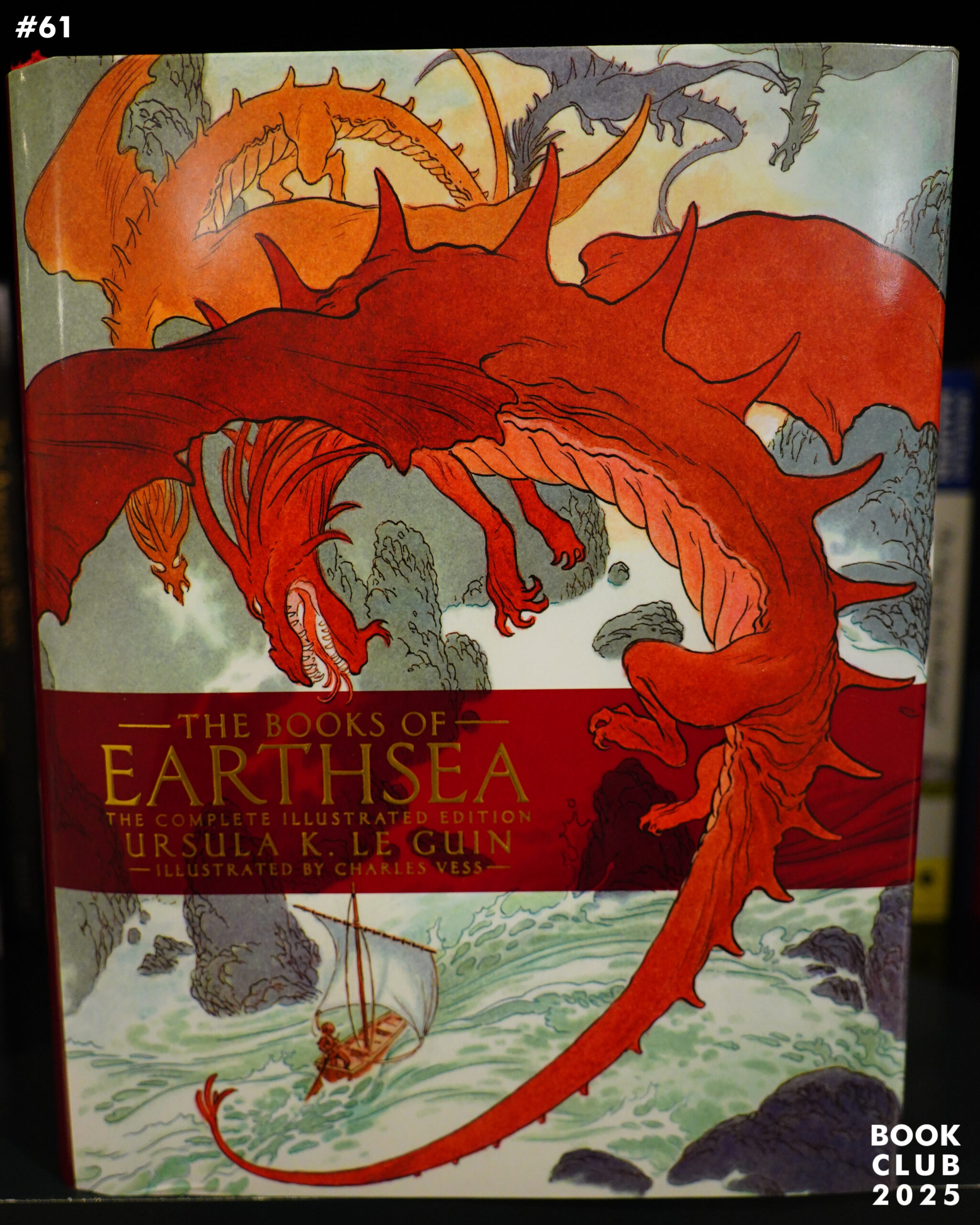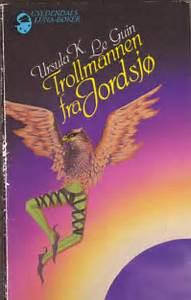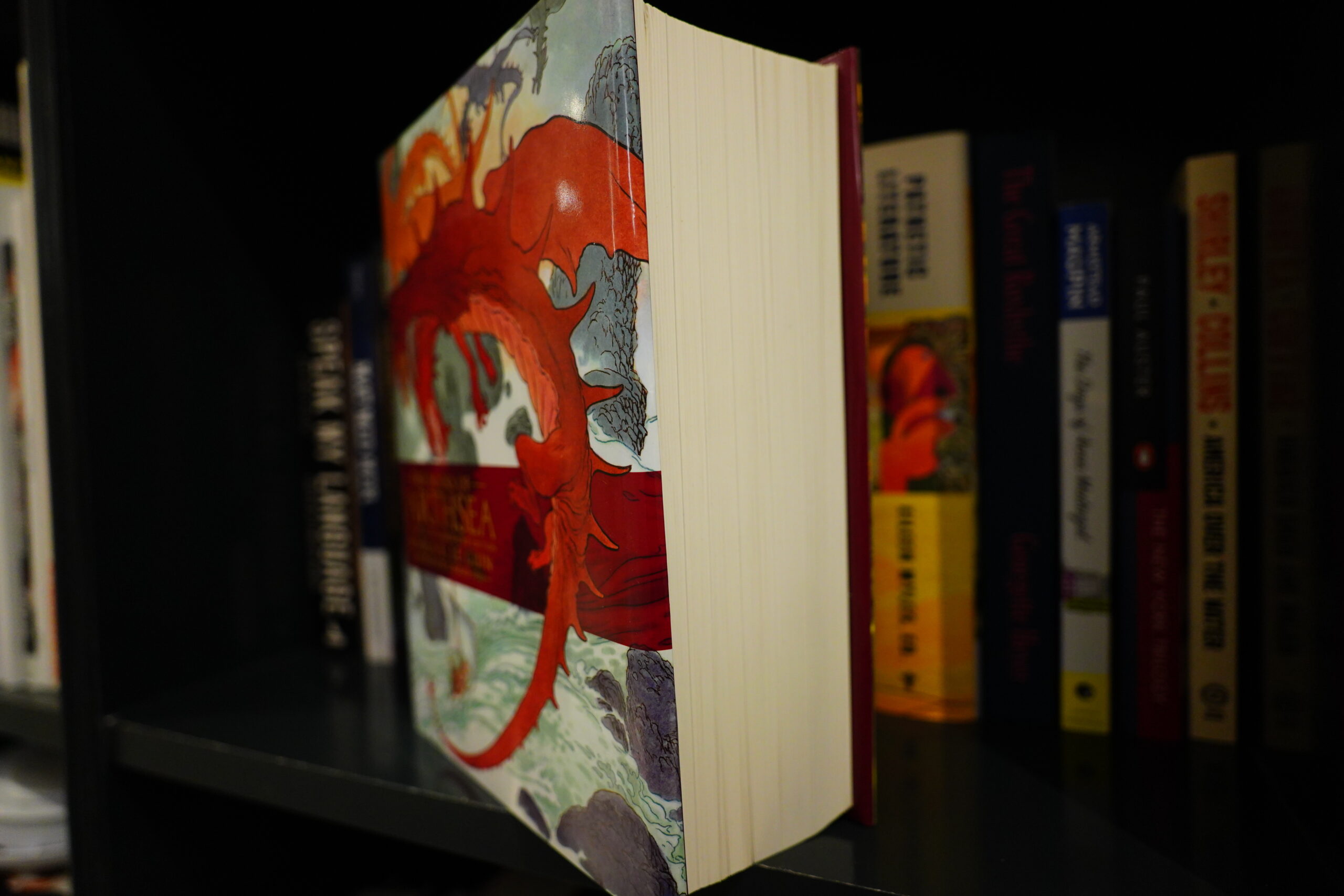I discovered that they’d published a complete, illustrated version of the Earthsea cycle a couple weeks ago. I’m not overly fond of omnibus editions, but this is illustrated by Charles Vess, and I love his artwork, so I thought that this might be a good time to re-read these books.
Because of course I’ve read these books before. I read the first one (in translation) when I was about 10-11 years old, and it had the cover above. I had that book, so I read it several times, but the other two of the first trilogy I borrowed from the library, so I probably just read them once?
(Man, that’s a weird cover. Le Guin complains about horrible covers, but she doesn’t mention this one.)
This book is massive. It’s just almost 1K pages, but they’re big pages. Looking at the original editions, it looks like the six books altogether were 1,400 pages, and this one also includes some other short stories and stuff, so there’s some heft to this book.
Vess does illustrations of key scenes, as well as title plates…
… and one colour piece per book.
Charles Vess has done some extremely stylish comics, and those are mostly pen and ink. This is just pencil, and of course it’s good looking, but I have to admit I’m a bit disappointed.
I was also going to quibble about how he depicts some things, like the dragons, but the artwork was done over four years, and in collaboration with Le Guin. I guess if she say’s that that’s correct, I can’t really argue. Darn!
Now, as for the text itself… I mean, just reading it, I don’t think this format is ideal? I guess they had to limit themselves to under 1K pages or something, so they had to step down the font size slightly. I mean, it’s not uncomfortable, but it’s just a smidgen too small. And since the pages are so big, they felt the need to increase the line height, so that your eyes can snap back to the left side of the page without losing place.
I just thing the look of these pages isn’t ideal. But it does give you the feeling you’re reading some old huge grimoire, which is probably what they were going for, and that’s fun.
But since it’s uncomfortable to hold, and also slightly uncomfortable to read, I just read the old editions I had. D’oh! But I did look at the illustrations, too.
(And I couldn’t find The Other Wind, so I read that from this new collection, along with the afterwords and the extra included short stories and stuff.)
So how is it? Presumably, you’ve all read these books — or at least the first three.
I had forgotten how oldee tymey the first book is. It’s written in a style halfway between fairy tales and modern “classic” fantasy. That is, people are introduced like “and then he met Grumbledork, who would go on to sail to Vinklebump and vanquish Zomplefart, the dragon, but that’s a story for another day”, etc etc. As someone who hates fairy tales… I really enjoyed it. As much as I did when I was 11.
I think the second book, The Tombs of Atuan is generally considered to be the best? It’s written in a very different way, and it is indeed very good. But I think of the first three books, I prefer the third, The Farthest Shore. It’s like a remake of the first book (a road movie, but at sea), but the encounters are more memorable and vivid — like the people who live at sea all their lives, in the floating cities, and so on. And it has the most moving end.
Then 30 years passed, and the fourth book came, Tehanu. If you were 11 years old in 1991, and read the four books in quick succession, you’d get whiplash when you got to the fourth one: It starts with a five year old girl who was raped and then put into a campfire to burn to death. (And that’s just the first page.) But if you grew up with the first three books, and then got to the fourth as an adult (as I did), then it seemed quite natural: It’s a brutal, angry book, and it’s fantastic.
Ten more years passed, and we got a short story collection — but times have moved on, and “short” isn’t the same as in the olden days. The first story in the collection is about two thirds the length of the first novel. All the stories are solid, and we retrench a lot from the harshness of Tehanu. Le Guin says she wrote the stories to figure out herself how to finish off the series with the fifth novel, and to explore things about Earthsea. Now, nothing strikes more fear into a reader’s heart than an author who wants to “explore things” in their universe: You’re likely to get a story filling you in on the “lore” of the second lieutenant mentioned in half of a sentence in book two, and nothing in the short story must affect the “proper” novels whatsoever. But of course, Le Guin does nothing of the kind: She writes interesting stories that fill in the milieu and enriches your love for the world, and not trite info dumps or backstory you’ve never asked for.
And finally, the sixth and final book came hot on the heels of the fifth, and it’s a novel that manages to be a wonderful ending to the entire series. I had totally forgotten that. It echoes the first and third books storytelling wise, and concludes the storylines started in the fourth book, while starring (sort of) Tenar from the second book. Some people when they finish a series like this seem to have a checklist of points they go through and make everything neat — Le Guin is way too smart to do something like that, but it’s a really solid ending to the cycle.
(Except that there are a few more short stories included in this collecion. The final story was published in The Paris Review originally in 2018, after Le Guin had died, and is a very moving coda.)
So to sum up: These books are still darn good, and even better than I remembered.
And now I want to read something that’s not fantasy.
The Books of Earthsea (2018) by Ursula K. Le Guin (buy new, buy used, 4.46 on Goodreads)










Pingback: ycombinator.com